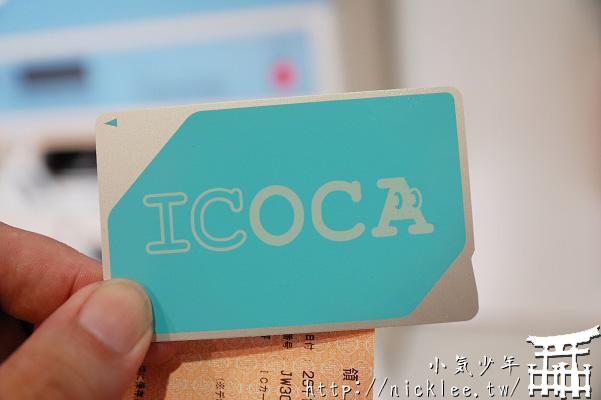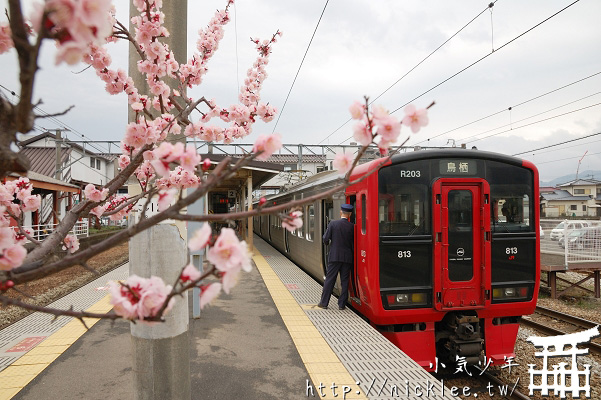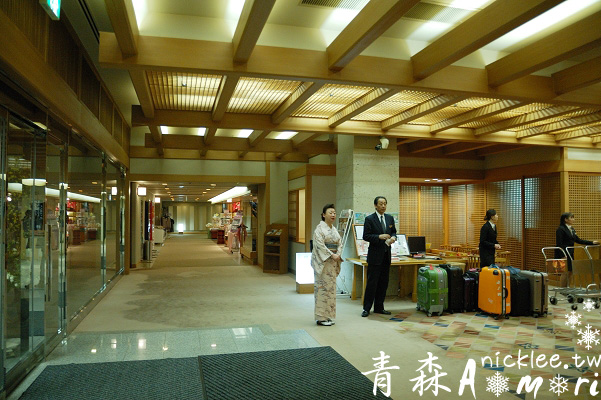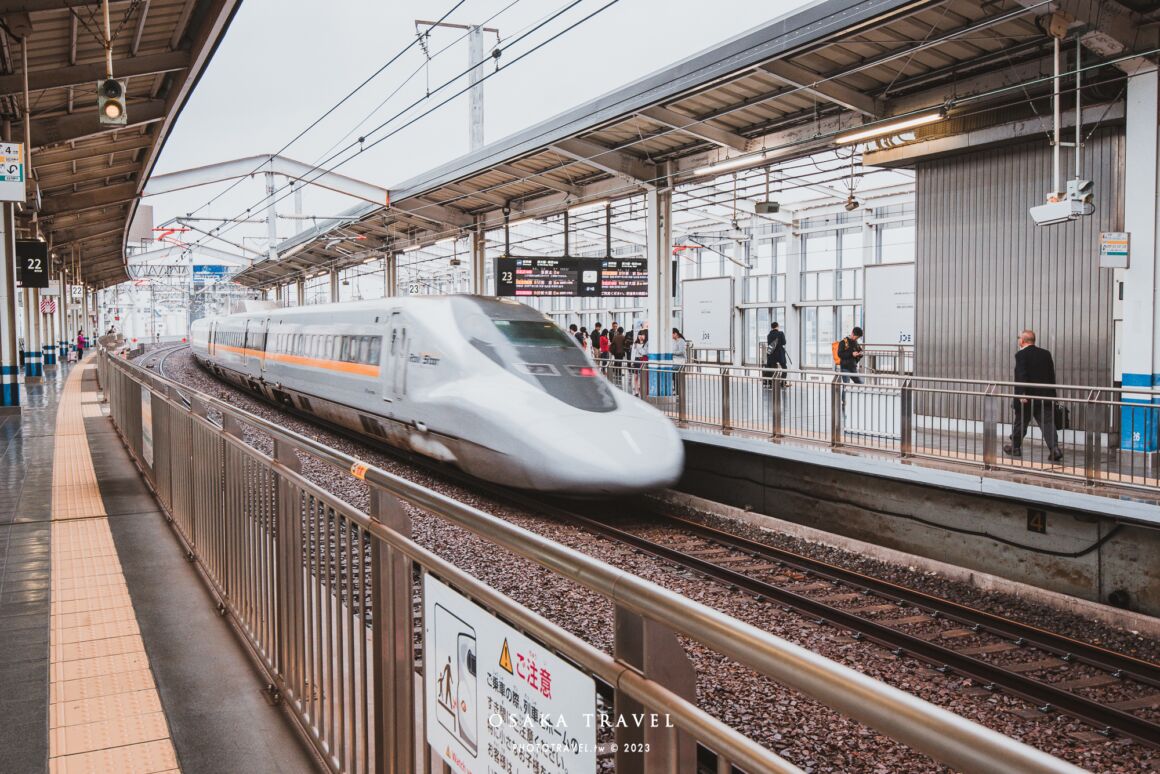ICOCA, issued by JR West, can be used throughout Eastern Japan, Tokai, and Hokkaido.
It is similar to Taipei’s EasyCard or Tokyo’s Suica card, allowing you to use it for transportation, shopping, and other expenses.
It serves as an electronic wallet and a rechargeable card, not a never-ending travel pass!

Types
ICOCA is mainly divided into two categories, namely General ICOCA and ICOCA regular tickets.
General ICOCA can be further divided into ICOCA, Child ICOCA (shown in the picture below), and SMART ICOCA.

ICOCA regular tickets are also divided into: ICOCA regular tickets, children’s ICOCA regular tickets, and SMART ICOCA regular tickets.

Which card will we use among so many? Usually, it’s just ICOCA and Child ICOCA…
But let me explain the others that we won’t use anyway!
The general ICOCA is an anonymous rechargeable card that anyone can purchase and use.
Child ICOCA is the same as the general ICOCA, but its cost is half of an adult’s.
Therefore, it cannot be purchased through the general ticket machines.
You need to fill out a form with relevant information such as your passport to apply for its purchase.
1. Children’s ICOCA is limited to children aged 6 to 11 years old for purchase.
2. If you wish to purchase a children’s ICOCA, please accompany the child to the “Green Window” and present the “Child Passport” for purchase.
SMART ICOCA is a bit more complicated.
However, if you want to purchase it, you first need to have a credit card. Then, you can apply for it on the website or at the counter. (Click here for the application method)
The advantage of SMART ICOCA is that you can top up using a credit card, so you don’t need to carry cash and can still use it.
And the regular tickets is equivalent to a monthly ticket.
The regular version can be purchased at ticket machines.
However, if you are just a regular tourist, you won’t need it~ because this is only applicable for commuting.
Scope of Use
ICOCA is like Taiwan’s EasyCard, iPass, and Hong Kong’s Octopus Card.
It is an electronic wallet card. Not only can it be used for transportation, but also for shopping.
Its main usage areas are as follows:
1. Railway: In addition to the JR West lines that it can be used on, it can also be used on PiTaPa in the Kansai region, PASPY in the Okayama and Hiroshima regions, toICa on JR Tokai, Suica in the JR East Japan metropolitan area, Niigata, and Sendai.
However, it is important to note that while it can be used in other areas, it cannot be used across regions! “Across regions” means that you cannot enter the JR West area and exit in the JR Tokai area, and so on.
2. Shopping: You can shop at various restaurants and convenience stores such as Matsuya, AEON Department Store, Family Mart, Lawson, etc. (Stores that accept ICOCA will display the ICOCA logo at the counter).
3. Parking: You can use the 24Times parking lot.
Due to the wide range of railways available, it is important to understand the “basic range” and “extended range”.
The “basic range” refers to the original range that the card itself can be used in.
The “extended range” refers to the range that can be used due to cross-industry alliances with other companies.
ICOCA Basic Coverage
Basically, it can be used on most of JR West’s routes. The available range in the Kansai region is as follows:

Below is the detailed route map of ICOCA (click on the small image to enlarge)

Extended Scope 1
ICOCA is mainly affiliated with the Pitapa in the Kansai region, so the Pitapa area (referred to as the Pitapa zone) can also be used with ICOCA.
The areas where Pitapa can be used are as follows (mainly private railways and subways in the Kansai region) or download it here.
Please note that this route map is slightly different from the one that KTP can use.

Railway Tram Section
Osaka Metro, Kyoto Municipal Subway, Kobe Municipal Subway,
Hankyu Railway, Keihan Electric Railway, Hanshin Electric Railway,
Kintetsu Railway, Nankai Electric Railway, Randen,
Sanyo Electric Railway, Kobe Electric Railway, Osaka Monorail,
Semboku Rapid Railway, Kobe New Transit (Port Liner, Rokko Liner), Kobe Rapid Transit Railway,
Kita-Osaka Kyuko Railway, Nose Electric Railway, Hokushinkyuko Railway,
Mizuma Railway, Hankai Tramway
Bus Section
Kyoto City Bus, Osaka City Bus, Kobe City Bus, Nara Kotsu Bus, Takatsuki City Bus,
Itami City Bus, Hankyu Bus, Hankyu Denen Bus, Shintetsu Bus, Shinki Bus,
Shinki Regional Bus, Shinki Green Bus, West Shinki Bus, NC Bus (Nara Kotsu Bus), Keihan Bus,
Keihan Kyoto Kotsu Bus, Kobe City Transportation Promotion Yamanote Bus, Sanyo Bus, Hanshin Bus,
Mizuma Railway Bus, Kojaku Hotsu Bus, Nankai Bus, Kyoto Bus,
Ohmi Railway Bus (Excluding Hinocho Bus, Kusatsu City Mame Bus, Kusatsu・Kurito・Moriyama Kurutto Bus),
Mizumi-koku Bus (Only buses operated by Hikone Office, operating in Hikone City, Taga-cho, Kora-cho), JR Bus (Takao Line, Keihoku Line),
JR Express Bus: JR Osaka・Kobe ~ Kobe-Sanda Premium Outlet Line, JR Kobe ~ USJ Universal Studios Line, JR Kobe・Osaka ~ Arima Onsen Line,
Kansai Airport Limousine Bus: Limited routes and transportation companies, for details please click here to inquire.
The following will be available starting from 2024.02.24
Fukui Railway Bus (excluding general routes – Ferry Line, Oshima Line, Hongo Line, shuttle bus – Echizen City Citizen Bus, and Echizen Town shuttle bus)
Keifuku Bus (except some shuttle buses)
Pitapa is not only available in the Kansai region, but also in Shizuoka and Okayama.


There are various modes of transportation available in the Kansai region, but ICOCA cannot be used.
Any sightseeing mountain bikes, cable cars, and the Arashiyama Torokko train cannot be used with ICOCA.
Extended Range 2
As long as it falls within the range of the following 10 IC cards, ICOCA can also be used!
The area where Kitaca can be used is called the Kitaca Area.
The area where TOICA can be used is called the TOICA Area.

Price
First purchase of ¥2000, including a deposit of ¥1500 and a card deposit of ¥500.
Top-up
At least one thousand, the rechargeable amounts are: 1000, 2000, 3000, 5000, 10000.
However, a card can only hold a maximum of 20,000 yen.
Expiration Date
After purchasing the card, you can start using it.
(It will only expire if it hasn’t been used within 10 years from the last usage date. However, I personally tested it and found that it can still be used even after more than 10 years of non-usage.)
Sales Location
Mainly at the self-service ticket machines in JR West stations (including the ones at Kansai Airport station).

Overseas Purchasing: Currently, KKDAY offers overseas purchasing services.
You can obtain the card before your trip to Japan, saving you the trouble of buying tickets in Japan.
Purchasing: Click here for more information.
How to Purchase
Some machines have the ICOCA purchase button directly designed on the outside.
You can simply insert 2000 yen and then select the button (red arrow).
Afterwards, it will ask you if you need a receipt. The red box is for requesting a receipt, while the green box is for not needing a receipt.

Some older machines display the purchase button for ICOCA on the screen, as shown in the red box in the image below.

Return Card
Card Return Location: Card returns can only be processed at the ticket windows of various stations within the usage area of JR West’s ICOCA.
(Card returns can also be processed at the green windows of JR Kansai Airport Station, but it is not recommended due to the large number of people.)
Tokyo, Nagoya, Hokkaido, and Kyushu are unable to process ICOCA card refunds.
Card Refund Fee: ¥220
Explanation:
When returning the card, if there is a remaining balance, a refund fee of ¥220 will be deducted, and then ¥500 deposit will be returned to you.
If the balance is less than ¥220, only ¥500 will be refunded.
(In other words, even if you have used up the balance and return the card, they will still refund you ¥500)
★ How to say “cancel card” to a Japanese person?
★ In Japanese, you can say “払いもどし” (pronounced: HaRaI MoDoShi) to convey the same meaning.
(Or you can write it down for them)
Usage Instructions
Just like Taipei’s EasyCard, it can be used by simply tapping.
The area with the red arrow is where you can tap your ICOCA card.


The following image shows the usage method of the induction card, obtained from Wikipedia.

Top-up Locations
You can top up your card at the self-service ticket machines or top-up machines located at various railway stations.
Alternatively, you can also visit the checkout counter at major convenience stores to top up your card.
Vending Machine
Each region has its own dedicated recharge machine, or you can use the automatic ticket vending machine or fare adjustment machine for recharging.
In the image below, the machine on the right is a recharge and fare adjustment machine (used for ticket supplementation), while the machine on the left is exclusively for Smart ICOCA (regular ICOCA cards cannot be used).

【Top-up Method 1A – JR Station Ticket Machine】
1. Insert your ICOCA card (indicated by the red arrow in the image below).
2. Select the desired top-up amount (green arrow).
3. Insert the appropriate amount of money (yellow arrow, with separate coin and bill slots).

【Top-up Method 1B – Top-up Machines at Various Metro or Private Railway Stations】
The following image shows the method of recharging the automatic ticket machine (automatic commuter pass issuing machine) of the Keihan Electric Railway.
Whether or not it is possible to recharge depends on the location. You can pay attention to whether there is an ICOCA sticker on the machine, as shown in the red box in the image below.
The green box is the recharge button. After pressing it, insert the ICOCA card (the red arrow indicates the ICOCA card insertion slot).

Insert the ICOCA card into the machine.

Then it will display the amount to be deposited.
I plan to deposit 3000, so just press the right side 3000 yen.

The machine is asking me for money.

I only have three 1000 yuan bills, so I can put them in all at once.
(Up to 10,000 yen bills can be inserted.)

After placing it, the displayed amount to be inserted is 3000 yen.
If you want to request a receipt, press “領收書あり” (which means “Receipt Available”).

Then, ICOCA will be returned to you.
The following image shows the situation when the receipt is returned.

The following video shows the actual process of topping up at the ticket machines of JR and Kyoto Municipal Subway.
【Top-up Method 2 – Convenience Store】
At the counter, hand your ICOCA card to the staff and inform them that you would like to top up (charge).
Then, present the amount you wish to top up to the cashier.
Subsequently, the cashier will ask you to place the card on the card reader in front of the cash register or on the table.
After the top-up is completed, the cashier will return your ICOCA card to you.
Additional Explanation
1. Many people often ask if the transportation cards ICOCA or Suica can be used.
The following are buses in the Kyoto area.

The following is the railway system in the Kyoto region.

The following are bus services in the Osaka, Kobe, and Nara regions.

The following is the railway network in the Osaka, Kobe, and Nara regions.

Wakayama and Osaka Izumisano Area:
1. Wakayama buses cannot yet use ICOCA, Suica, and other IC cards.
2. Nankai buses: Nankai Main Line from Sakai Station to Izumiotsu Station, Nankai Koya Line from Sakaihigashi Station to Mikano-dai Station, Izumisano Station on the Izumisano Rapid Railway to Izumi-Chuo Station, JR Hanwa Line from Sakai-shi to Izumifuchu Station. Nankai buses in these areas can use ICOCA, Suica, and other IC cards.
2. Some stations on certain routes do not have automatic ticket machines. Instead, they have installed onboard automatic ticket machines (Japanese: 車載型IC改札機).
Due to the low usage of some train stations, IC card readers have not been installed.
Therefore, if you enter these stations, you won’t be able to use your IC card. To address this issue, JR West has installed IC ticket gates on the trains operating on these routes.
Typically, one gate is placed near the entrance and another near the exit.
When boarding from the rear door, please tap your IC card on the reader.
When alighting, please exit through the front door and tap your card in front of the driver, where the IC ticket gate is located.
Currently, there are many routes that have installed onboard IC ticket gates, as follows:
Nanao Line: Tsubata – Nanao
Kansai Main Line: Kameyama – Kamo
Wakayama Line, Kisei Main Line (Kinokuni Line), Sakai Line: All line.
The following image is an explanatory diagram of the Sakai line.

4. Not every station allows the purchase of ICOCA or top-up services.
Starting from March 13, 2021, a new section of the JR Kansai Main Line, from Kamo to Kameyama (with Kameyama to Nagoya section within TOICA coverage), has been added.
Although ICOCA can be used at every station along the Kamo to Kameyama section, not every station allows the purchase or recharge of ICOCA.
Stations where ICOCA can be purchased: Kamo, Iga-Ueno.
Stations where ICOCA can be recharged: Kamo, Kasagi, Iga-Ueno, Kameyama.
For more details, please refer to the official website.
In addition, the fares for the Nanao Line, Wakayama Line, and Kisei Main Line (Kinokuni Line) can be paid with cash using the fare boxes on the train! However, the Kansai Main Line and Sakai Line cannot be topped up on board!
5. Cannot be used across regions!
The use of ICOCA is limited to the ICOCA area, while the neighboring area is the TOICA area of JR Tokai.
If you plan to take the JR from Kyoto to Nagoya, you can only purchase tickets with cash at the ticket machine or counter, and you cannot directly use the IC card to enter the station.
Then, you can use the IC card to exit the station because although the IC cards are interoperable, they cannot be used across different areas for “one-time entry and exit.”
In other words, you cannot enter Kyoto Station using ICOCA and then exit Nagoya using ICOCA.
ICOCA Frequently Asked Questions
Q1: Can ICOCA be used to take buses in the Kansai region?
A1:
In Kyoto, you can use ICOCA for Kyoto City Bus, Kyoto Bus, Keihan Bus, and West Japan JR Bus.
In Kobe, you can use ICOCA for City Loop and Kobe City Bus.
In Osaka, you can use ICOCA for Osaka City Bus.
In Nara, you can use ICOCA for Nara Kotsu Bus, but not for Limousine, Express (Hanna), High-Speed, and Night Buses.
Q2: Can ICOCA be used to ride on private railways such as Hankyu, Hanshin, Kintetsu, Nankai, Keihan, etc.?
A2: Yes, it can… You can ride on the trains of these private railway companies. (However, it does not include mountain trains or cable cars operated by the company.)
Q3: Are there any restrictions on which types of trains ICOCA can be used on?
A3: There are no restrictions, ICOCA can be used on any type of train. This is because ICOCA is used for paying the fare.
However, if you are taking a limited express train (JR, Nankai Railway, Kintetsu Railway) that requires an additional fee, you will need to purchase a limited express ticket separately with cash.
Q4: Are there any discounts when using ICOCA?
A4: There are no discounts when using ICOCA for fare payment. When boarding, the fare is the same as regular fares.
Q5: Can I return my ICOCA card in other regions?
A5: You can only process card returns in the JR West region. Please go to the JR counter to handle the return.
Q6: Where can I buy ICOCA at Kansai Airport?
A6: You can only buy it at the Kansai Airport station. The regular version is available at the JR ticket vending machines, while the child version can be purchased at the green counter.
For detailed location information, please refer to the Kansai Airport introduction article.
Q7: Can I use ICOCA to purchase tickets or vouchers at ticket machines?
A7: Yes, you can.
Q8: Can I use my ICOCA card to enter the station and have the limited express fare deducted directly?
A8: When you swipe your card to enter the station, no charges will be deducted. The fare will only be deducted when you exit the station.
(Since the card cannot determine which train you are boarding, it is not possible to deduct the limited express fare when entering the station.)
Q9: What should I do if I use ICOCA to ride on JR, Nankai, and Kintetsu limited express trains?
A9: Please prepare cash to purchase additional tickets. (ICOCA does not deduct the limited express fare when you enter the station. The limited express fare needs to be paid separately.)
Q10: Can ICOCA be used to purchase Arashiyama Electric Railway one-day passes, Hankyu one-day passes, and other tickets?
A10: No. (There may be a few exceptions.)
Q11: After returning the ICOCA card, can it still be kept as a souvenir?
A11: No, it cannot. If you want to keep it, you cannot return the card.
Q12: Can ICOCA be used to ride on JR Express trains?
A12: ICOCA is only used for entering and exiting the station. Therefore, it can only be used to deduct regular fare.
As for riding on express trains, you need to purchase a separate express ticket because the ticket gates cannot recognize which train you want to ride.
Unless you can use ICOCA to purchase an express ticket at the ticket vending machine in advance, you will need to purchase the express ticket separately with cash or onboard.
(Of course, when entering and exiting the station, you only need to use ICOCA.)
Q13: What should I do if I use ICOCA to travel to an area outside the designated usage area (e.g. Amanohashidate)?
A13: There are a few options.
1. If you only travel outside the usage area but still within a JR station, you just need to ask the station staff to clear the record when you exit and then pay the fare in cash. However, if the station does not have the necessary equipment, you will need to find a way to return to a station where the record can be cleared.
2. If you are traveling to a non-JR station, you must go through the fare adjustment process at a JR border (connecting) station, such as Fukuchiyama Station. Then, you can proceed to purchase a new ticket for the Hokushin Kyuko Railway (KTR).
3. If you want to go directly to Amanohashidate, there are two things you need to do.
a. Go to the manned ticket gate and show your ICOCA card to the staff there. They will calculate the fare, collect the payment, and issue a certificate.
b. Before using your ICOCA card again, show the certificate and ICOCA card to the station staff at the manned ticket gate for verification and setup.
So, if the place you want to go to doesn’t accept ICOCA, it is recommended to buy tickets directly.
Q14: When using ICOCA at the ticket gate, if the balance is insufficient, can it be directly settled by adding the remaining amount?
A14: Yes, it is possible. It is treated as a regular settlement method. After inserting the insufficient balance, the settlement machine will dispense a “ticket”. At this point, when going through the ticket gate, you should use this ticket instead.
(Not all private railways allow settlement before exiting the station, some require you to top up first before exiting.)
Q15: Can Suica and other cards be recharged at ICOCA machines? Or can ICOCA be recharged at Suica and other machines in other regions?
A15: Yes, you can. However, please note that the ticket vending machines or recharge machines will have stickers indicating the cards that can be used. Before using, please pay attention to them. (Refer to the red sticker in the image below)

Q16: Can ICOCA be used in various regions of Japan such as Tokyo, Hokkaido, Kyushu, etc.?
A16: Yes, it can. Currently, it is widely accepted nationwide, with only a few private railway and bus companies unable to accept it.
(Please note that it cannot be used across regions, for example, you cannot enter a station within the JR West area and exit within the JR Tokai area.)
Q17: How to check the balance of the card?
A17: Please refer to another article: [APP] Checking the balance of Suica and ICOCA – Suica Reader.
Q18: Is ICOCA, when used in the Tokyo area, priced at ¥1 per ride like Suica?
A18: Yes.
Reference Materials
■ JR West – ICOCA Official Website
『Original Source:https://nicklee.tw/1146/』





